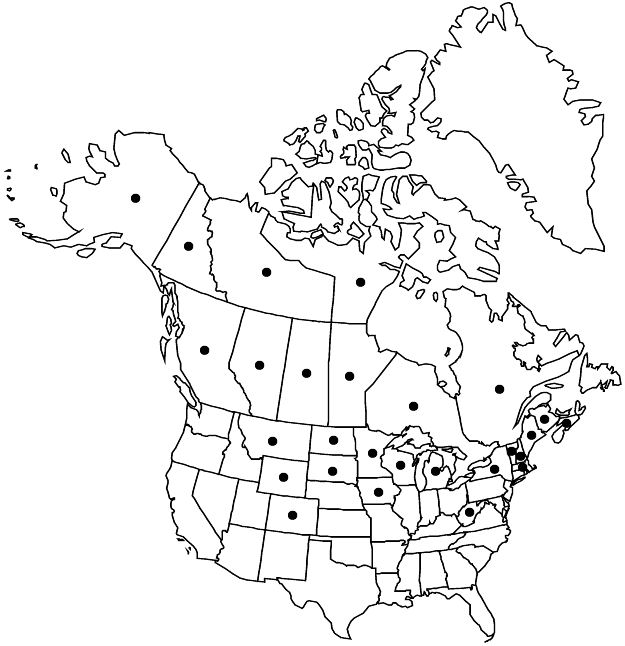Rosa acicularis
Ros. Monogr., 44, plate 8. 1820.
Shrubs, forming dense thickets. Stems erect, stout, (3–) 10–20 (–25) dm, sparsely or densely branched distally; bark pale-brown with tips dull red, glabrous; infrastipular prickles absent, internodal prickles dense, erect, subulate, terete, ± flattened, 9 × 4 mm, sparsely stipitate-glandular, mixed with dense aciculi. Leaves 5.5–15 cm; stipules 20–25 × 3–8 mm, auricles flared or erect, 5–7 mm, margins usually entire, stipitate-glandular, surfaces glabrous, sometimes puberulent, sparsely sessile-glandular or eglandular; petiole and rachis usually (rarely) with pricklets, glabrous or puberulent to pubescent, sessile-glandular; leaflets 5–7 (on annual shoots), terminal: petiolule 6–20 mm, blade elliptic, ovoid, or ovatelanceolate, 20–60 × 13–32 mm, firm, margins 1 (–2+) -dentate-serrate, teeth 11–25 per side acute or obtuse, gland-tipped or eglandular, apex acute or obtuse, abaxial surfaces light green, glabrous or puberulent (on main veins), eglandular or sparsely to densely sessile-glandular, adaxial green, dull, glabrous or sparsely hairy. Inflorescences corymbs, 1 or 2 (or 3) -flowered. Pedicels reflexed as hips mature, slender, (13–) 20–28 (–35) mm, glabrous, stipitate-glandular or eglandular; bracts 1–3, ovoid, 18–22 × 4–14 mm, margins entire, sessile or short-stipitate-glandular, surfaces glabrous, sometimes hairy, eglandular. Flowers 3–6 cm diam.; hypanthium ovoid to oblong, 5–8 × 4–6 mm, glabrous, eglandular, neck 1 × 2.5–3 mm; sepals spreading, often beak-capped, lanceolate, 20–33 × (2.5–) 3–3.5 mm, tip 7–12 × 0.5–0.8 mm, margins entire, sometimes pinnatifid, abaxial surfaces glabrous, sometimes pubescent, eglandular or stipitate-glandular (north); petals single, rose-pink to pale-pink, (13–) 22–25 × (11–) 20–25 mm; stamens 75–100; carpels 18–33, styles exsert 1 mm beyond stylar orifice (2 mm diam.) of ± flat hypanthial disc (3.5–4.5 mm diam.). Hips orange-red to bright red or blue-purple, globose to ellipsoid or urceolate, 10–23 × 9–11 mm, fleshy, glabrous, eglandular, neck 1–2 × 2–2.5 mm; sepals persistent, erect, often beak-capped. Achenes basiparietal, 14–25, tan, 4 × 2–2.5 mm.
Distribution

Alta., B.C., Man., N.B., N.S., N.W.T., Nunavut, Ont., Que., Sask., Yukon, Alaska, Colo., Iowa, Maine, Mass., Mich., Minn., Mont., N.Dak., N.H., N.Y., S.Dak., Vt., W.Va., Wis., Wyo., Eurasia
Discussion
Subspecies 2 (2 in the flora).
Rosa acicularis is circumpolar in forests of Eurasia and North America. Octoploid subsp. acicularis occurs from Sweden across northern Russia to Outer Mongolia, northern China, Korea, and Japan; hexaploid subsp. sayi is found throughout northern North America. The two subspecies meet in an intergradation zone from eastern Siberia to Alaska, and perhaps Yukon (W. H. Lewis 1958), where ploidy level is required for subspecies or hybrid confirmation.
Selected References
None.
Key
| 1 | Pedicels densely stipitate-glandular; leaflets 5 (or 7), margins 1(–2+)-dentate-serrate; sepal abaxial surfaces usually stipitate-glandular. | Rosa acicularis subsp. acicularis |
| 1 | Pedicels usually eglandular, if stipitate-glandular, not to apex or stipitate glands mostly sparse; leaflets 5–7, margins 1–2-dentate-serrate; sepal abaxial surfaces usually eglandular. | Rosa acicularis subsp. sayi |
"thin" is not a number."dm" is not declared as a valid unit of measurement for this property."dm" is not declared as a valid unit of measurement for this property."dm" is not declared as a valid unit of measurement for this property.